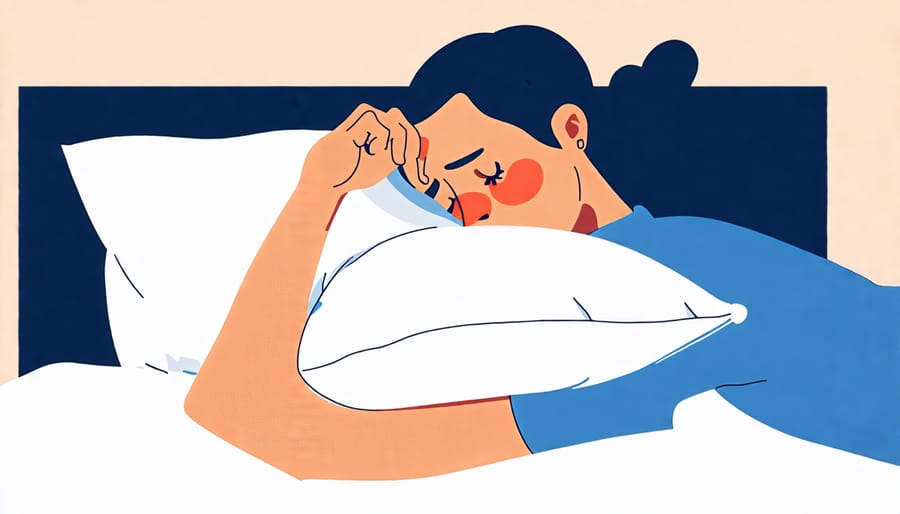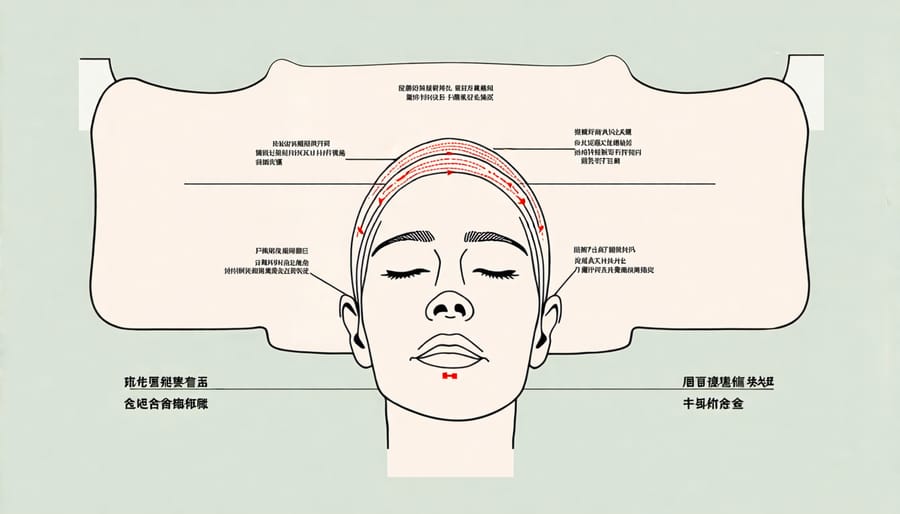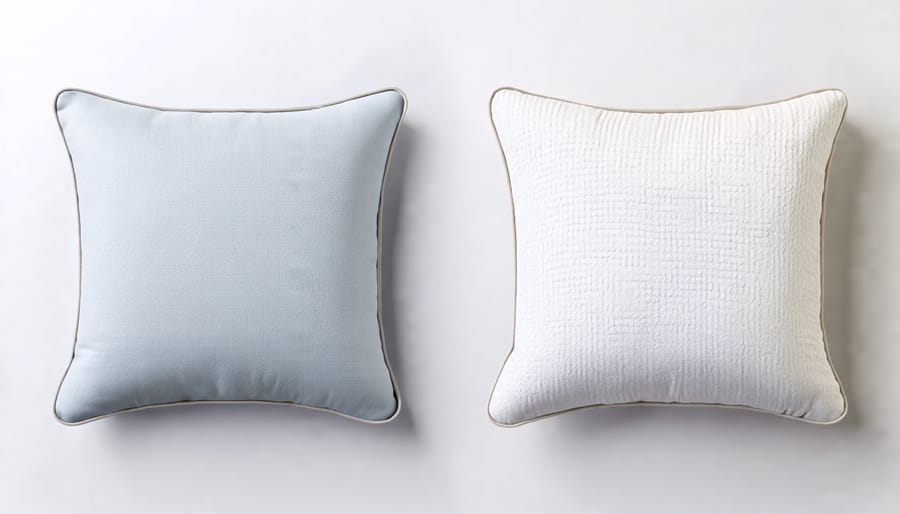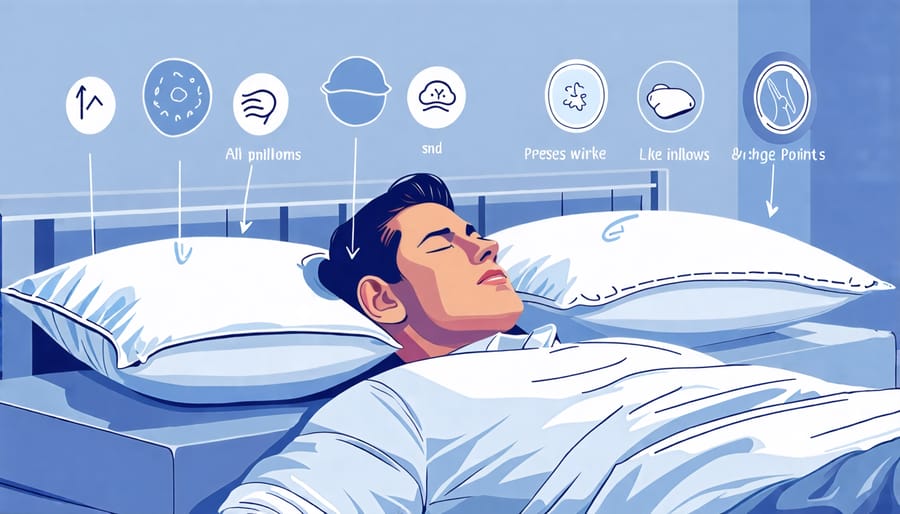Choose a pillow that properly supports your head and neck alignment to prevent muscle strain and nerve compression that can trigger headaches. Opt for a pillow with the right thickness and firmness for your sleeping position – thinner for back sleepers, thicker for side sleepers. Replace your pillow every 1-2 years as it wears out to maintain proper support. If you frequently wake up with headaches, consult your doctor to rule out underlying conditions, as pillows can cause headaches but may not be the only factor. Addressing sleep hygiene, stress management, and postural habits along with optimizing your pillow can help prevent pillow-related headaches.
How Pillows Can Trigger Headaches
Neck Misalignment
The alignment of your neck during sleep plays a significant role in preventing headaches. If your pillow is too high or too low, it can strain the muscles and ligaments in your neck, leading to tension and pain that can radiate into your head. Similarly, a pillow that is too firm or too soft may fail to provide adequate support, allowing your neck to bend at an awkward angle throughout the night. Over time, this misalignment can cause chronic headaches. To avoid this issue, it’s essential to choose a pillow that keeps your neck in a neutral position, with your ears in line with your shoulders. The ideal pillow firmness and height will depend on your individual sleeping position and preferences, so it may take some trial and error to find the perfect fit for you.


Pressure Points
Pressure points on the head and neck can play a significant role in pillow-related headaches. When a pillow is too high, too low, or lacks proper support, it can place excess pressure on sensitive areas like the occipital nerves at the base of the skull. This pressure can trigger tension headaches or exacerbate existing headache conditions. To avoid triggering these pressure points, it’s crucial to choose a pillow that maintains proper alignment of the head, neck, and spine. Look for a pillow with the right height and firmness for your sleeping position, as this can help distribute pressure evenly and reduce strain on specific points. Experimenting with different pillow types, such as memory foam or adjustable options, can also help you find the optimal level of support for your individual needs. By minimizing pressure point irritation through proper pillow selection, you can significantly reduce the likelihood of experiencing pillow-related headaches.
Unsupportive Materials
Certain pillow materials can exacerbate headaches due to their allergen content or lack of support. Down and feather pillows may trigger allergic reactions in some individuals, leading to congestion, sinus pressure, and headaches. Synthetic materials like polyester can also harbor dust mites, another common allergen. Overly soft or worn-out pillows that fail to maintain proper neck alignment can strain muscles and cause tension headaches. To minimize the risk of pillow-related headaches, opt for hypoallergenic materials such as memory foam or latex, and replace pillows every 1-2 years to ensure adequate support.
Choosing the Right Pillow to Prevent Headaches
Pillow Shape and Size
Pillow shape and size play a critical role in supporting proper head and neck alignment during sleep. Side sleepers typically benefit from thicker pillows to fill the gap between the head and shoulders, while back sleepers may prefer thinner pillows to maintain a neutral spine. Stomach sleepers should opt for the thinnest pillow possible or none at all to avoid straining the neck. Consider your body type when selecting pillow size – those with broader shoulders may need a wider pillow for adequate support. Contoured or cervical pillows can help cradle the neck and promote proper alignment. Ultimately, the best pillow shape and size is one that allows you to maintain a straight, neutral spine throughout the night, minimizing the risk of headaches caused by poor sleeping posture. Experiment with different options to find the most comfortable and supportive pillow for your individual needs.
Pillow Firmness and Support
Choosing a pillow with the right firmness and support is crucial for preventing headaches. A pillow that’s too soft may not provide enough support, causing your head and neck to sink into an unnatural position. On the other hand, an excessively firm pillow can put excessive pressure on your neck and shoulders, leading to tension headaches. The ideal pillow should keep your head, neck, and spine aligned in a neutral position. Consider your sleeping position when selecting a pillow – side sleepers typically require a firmer, higher pillow, while back and stomach sleepers may benefit from a softer, thinner option. Memory foam or adjustable pillows can be helpful in finding the perfect level of support for your individual needs. If you’re unsure about the best pillow for you, consult with a healthcare professional or a reputable pillow retailer for personalized recommendations.

Pillow Materials and Fillings
When choosing a pillow to prevent headaches, opt for materials that provide proper support and pressure relief, such as memory foam or latex. These materials contour to your head and neck, promoting proper alignment. Natural fillings like buckwheat hulls or kapok fibers are also good options, as they are adjustable and breathable. If you have allergies, look for hypoallergenic materials like bamboo, silk, or polyester fiberfill. Avoid pillows with excessively high loft or firmness, as they can strain your neck muscles. Ultimately, the best pillow material and filling for you will depend on your individual needs and preferences.
Other Factors Contributing to Headaches
While pillows can contribute to headaches, various other lifestyle factors also play a significant role. Stress, poor sleep habits, dehydration, and an unhealthy diet are common culprits that can trigger or worsen headaches. Managing stress through relaxation techniques like deep breathing, meditation, or yoga can help prevent tension headaches. Establishing a consistent sleep schedule and creating a comfortable sleep environment are crucial for reducing the likelihood of headaches. Staying hydrated by drinking enough water throughout the day and limiting caffeine and alcohol intake can also make a difference. Eating a balanced diet rich in fruits, vegetables, lean proteins, and whole grains while avoiding processed foods high in sugar and unhealthy fats can help maintain overall health and potentially reduce the frequency of headaches.
In addition to these lifestyle factors, certain medical conditions such as migraines, tension headaches, and sinus issues can contribute to chronic headaches. If you experience frequent or severe headaches, it’s essential to consult with a healthcare professional to rule out any underlying medical causes and develop an appropriate treatment plan. By addressing both pillow choice and overall lifestyle habits, you can take a holistic approach to preventing and managing headaches for improved well-being.
When to Seek Medical Help
While occasional mild headaches are usually nothing to worry about, there are certain situations when it’s important to seek medical advice. If you experience a sudden, severe headache that feels like the “worst headache of your life,” or if your headache is accompanied by symptoms such as confusion, vision changes, neck stiffness, or fever, it’s crucial to require medical attention right away. These could be signs of a more serious condition. Additionally, if your headaches are becoming more frequent, severe, or are interfering with your daily life, it’s a good idea to consult with your doctor. They can help identify any underlying causes, such as sleep disorders, posture issues, or even certain medications. Your healthcare provider may recommend keeping a headache diary to track potential triggers, adjusting your pillow or sleep position, or exploring other treatment options like physical therapy or stress management techniques. In some cases, imaging tests or a referral to a neurologist may be necessary to rule out other conditions and develop an effective treatment plan. Don’t hesitate to seek help if your headaches are causing concern – your well-being is worth it.

